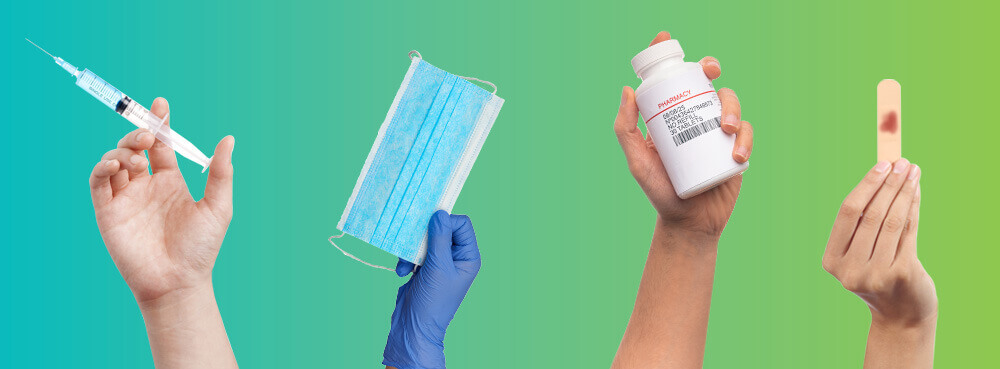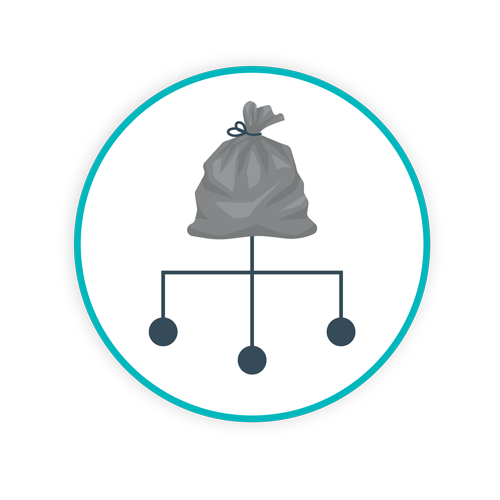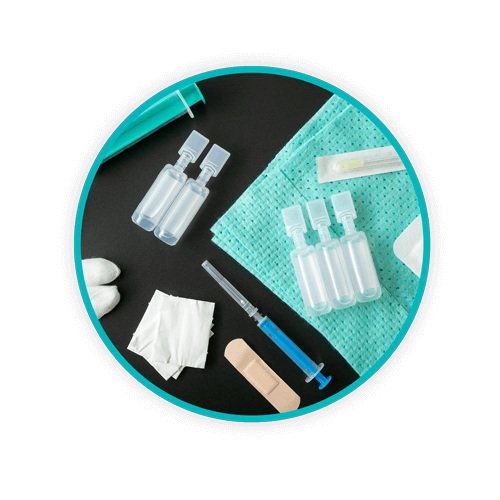What Is Regulated Medical Waste?

When asked what medical waste is, many people reply something along the lines of “Well, it’s anything used in medical care that ends up in a trashcan.”
Not exactly….
Healthcare providers including hospital networks, clinics, specialty practices, and the physicians and employees who work there should know that medical waste categories and definitions are much more complicated than that.
Knowing what is legally and environmentally considered regulated medical waste not only enhances safety for healthcare providers and caregivers, but also improves safety and wellness for the general public and the environment.
Understanding What Regulated Medical Waste is
Regulated Medical Waste (RMW), often referred to as “biohazardous,” “biomedical,” or “infectious” medical waste, can be defined as any waste that is potentially contaminated with blood, human body fluids, or other materials that could spread infections. This makes RMW a critical concern, especially in healthcare settings, where the health risks associated with spreading infections need to be meticulously managed.
Several specific types of waste fall under the “regulated” category, each with its unique handling and disposal requirements that often vary from one state to another.
What is Considered Regulated Medical Waste? | The Complexity of Medical Waste Categories
While the exact definition of regulated medical waste can vary, the essence of what regulatory agencies in the United States across the board consider regulated medical waste is surprisingly consistent. In essence, it’s about distinguishing ordinary medical waste from the kind that poses infectious risks, requiring special handling precautions. The approach to defining this waste category also differs from state to state. Some states prefer a broad definition, while others enumerate specific types of waste and categories that are considered infectious material.
In addition to regulated medical waste, there are six categories of healthcare-related waste examples that commonly fall under state regulation:
1. Pathological Waste: Also referred to as anatomical waste, this includes liquid and solid waste containing tissues, organs, body parts, and fluids removed during surgeries and autopsies, representing a significant part of what’s considered biohazardous.
2. Cultures and Stocks of Infectious Agents (Microbiological Waste): These are specimens from medical and pathology labs, including culture dishes and instruments used for transferring, inoculating, and mixing cultures, as well as discarded vaccines, whether live or attenuated.
3. Contaminated Sharps: This category includes any object that can puncture or slice skin and is contaminated, such as needles, syringes, scalpel blades, and broken glass.
4. Isolation Waste: Waste from patients isolated in hospitals to prevent the spread of communicable diseases falls into this category.
5. Contaminated Animal Carcasses, Body Parts, and Bedding: This includes waste from animals that were exposed to pathogens for research, biological production, or pharmaceutical testing.
6. Pharmaceutical waste: This category refers to discarded medications and other pharmaceutical products that are no longer needed, have expired, are contaminated, or are no longer considered safe for use. This category includes a wide range of items, such as prescription drugs, over-the-counter medications, vaccines, and cytotoxic drugs (used in chemotherapy), among others. However it is important to note that certain pharmaceuticals are considered hazardous, which is a separate, more heavily-regulated category of waste all together.
Each type of waste mentioned comes with its own set of disposal challenges and regulations, highlighting the critical need for comprehensive understanding and meticulous management. This is essential to maintain health and safety standards effectively in the healthcare setting.
Healthcare Waste Regulations – Legal and Environmental Considerations
Healthcare waste is not handled, stored, or disposed of the same way “across-the-board.” For example, pharmaceutical waste isn’t disposed of the same way as potentially infectious personal protective equipment (PPE). Sharps are not thrown into just any old red-bag waste container, but in specific and carefully placed sharps containers to prevent inadvertent needlestick injury, contamination, or available (and sometimes reused) by unauthorized users.
The Importance of Proper Segregation
In any healthcare environment, every individual healthcare worker in that facility should know how to categorize different medical waste streams for appropriate healthcare waste management. That means the ability to segregate different types of medical waste into appropriate containers and then temporarily store (appropriately) until final disposal.
Adhering to Federal and State Regulatory Requirements
In spite of the general list of RMW definitions provided in this article, it’s important to remember that medical waste disposal guidelines and the regulatory requirements of state and federal agencies are very specific. You can’t mess around with medical waste unless you want to risk massive fines, loss of reputation, and potential exposure of harmful substances to your employees.
Navigating Terminology
Guidelines and recommendations at the federal or state level often interchange terminology used in RMW waste management.
Environmental Protection Agency (EPA)
For example, the Environmental Protection Agency (EPA) offers their definition of medical waste as any “solid waste which is generated in the diagnosis, treatment, or immunization of human beings or animals.” That can define anything from protect personal equipment (PPE) to needles, syringes, bandages, or biopsy tissues, and more.
Occupational Safety and Health Administration (OSHA)
The Occupational Safety and Health Administration (OSHA) offers their definition of medical waste as any “red bag or infectious waste containing blood or bodily fluids that are: pourable, dripable, squeezable, or flexible.” This definition seems to imply that medical waste is only something that contains blood or blood products or other body fluids. It does focus on infectious waste, which is also often termed as biohazardous waste.
- Microbiological waste is typically also classified as a type of infectious waste that includes any biological materials including live vaccines or cultures dishes found in a laboratory, but can also pretty much define anything that increases the risk of infection to someone handling it.
Proper Medical Waste Management Practices
When it comes to medical waste management, the point is to know what is considered medical waste and how to handle it properly. Knowing how to separate different types of medical waste in any healthcare environment is important not only to maintain compliance, but to ensure safety and efficiency.
Know the difference between regulated and non-regulated medical waste. Follow guidelines of the EPA in identifying regulated medical waste, or any type of infectious medical or biohazard waste.
- Did you know that vomit, saliva, urine, feces, or other bodily fluids that don’t contain blood are not considered or categorized as medical waste?
- Do you know the difference between clinical waste and biomedical waste?
- What about the difference between infectious medical waste and pathological waste?
Don’t get confused. They’re all considered biomedical waste.
What is considered medical waste? Break that question down to be more specific. For example, what exactly is biomedical waste? Biomedical waste is defined as any type of medical waste that has the potential to be hazardous or infectious to humans. This can include anything; clothing, body parts, or blood contaminated with some type of substance such as a pathogen that can cause illness or disease.
Segregation, Handling, and Disposal Guidelines
1 / Know the Difference Between Regulated and Non-Regulated Medical Waste.
The vast majority of medical waste is unregulated but those producing it (medical waste generators) need to follow basic guidelines for collection, storage, and disposal of such waste.
2 / Know the difference between waste categories.
Instruct every employee in the healthcare facility to identify and properly classify the different medical waste streams produced by that facility. This is important to avoid mixing different types of waste, which is against many federal and state regulations.
Refer to the Resource Conservation and Recovery Act (RCRA) for specifics regarding guidelines involving segregation, handling, storage, and transportation and disposal of both hazardous and non-hazardous waste.
Pay attention to the regulations for the proper containment, storage, and disposal of different waste streams. For example, biohazard waste (such as blood products, IV tubing, infectious waste, or contaminated PPE) is to be disposed of in red regulated medical waste containers or red liners inside containers.
Sharps – not just needles – but also scalpels, staples, syringes, or any implement or tool with a sharp edge is to be placed in an approved sharps container. Sharps container placement is also important, not only in reducing inadvertent needlestick injuries, but to reduce availability and potential dangers to patients, the general public, and to keep them out of landfills.
For specific guidelines for identification and standards applicable to waste segregation, handling, storage and disposal, refer to the Code of Federal Regulations Title 40. Hazardous waste determinations can be found under Section 262.11 and aid waste generators in determining whether wastes are hazardous or not. Turn to the RCRA as well as state governmental agencies for determinations for proper medical waste management in your state, county, and facility.
Daniels Health encourages safety and compliance
Daniels Health encourages all medical waste generators to adopt the cradle-to-grave approach. This isn’t just a recommendation. It’s the law. Know what it is and what it entails. We’re here to guide you through state and federal regulations to ensure that your medical waste is handled, segregated, stored, and disposed of properly. This ensures not only compliance, but safety for your facility and your employees. Call us today for help setting up a workable and safe healthcare waste management system.
Let's Talk!
Your time is valuable, and we don’t want to play hard to get. You can either phone us directly on the details listed on our contact page, or feel free to fill out this short form and one of our team members will get back to you as quickly as possible.
